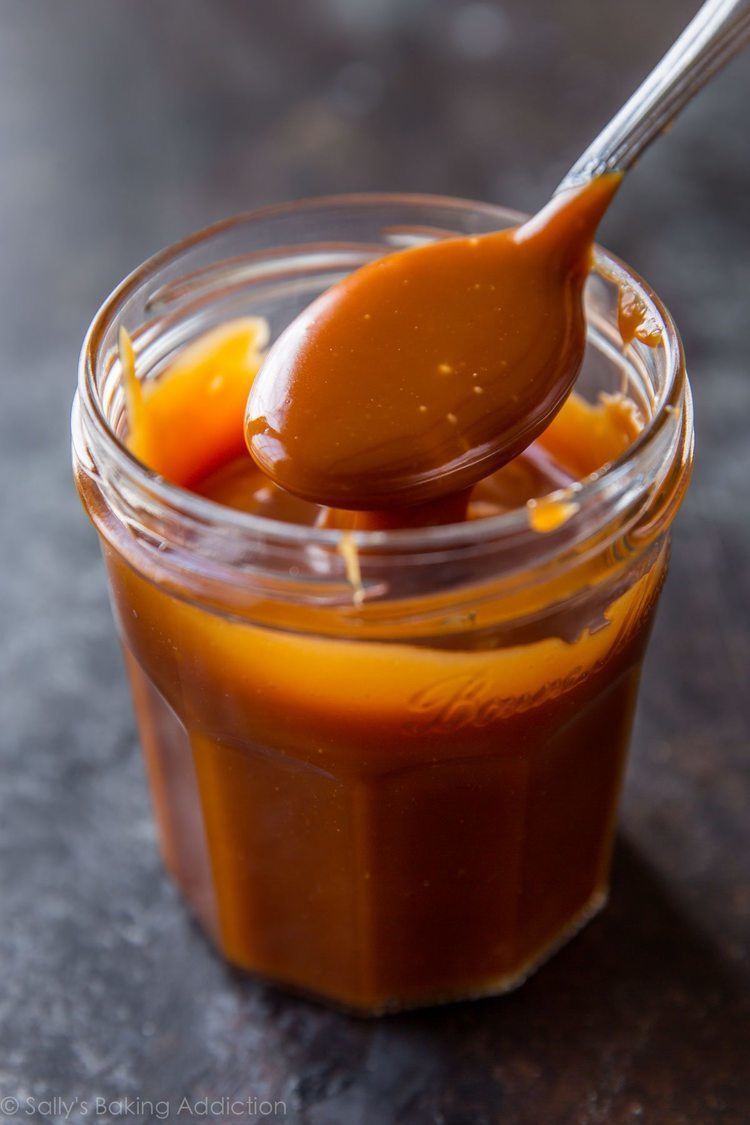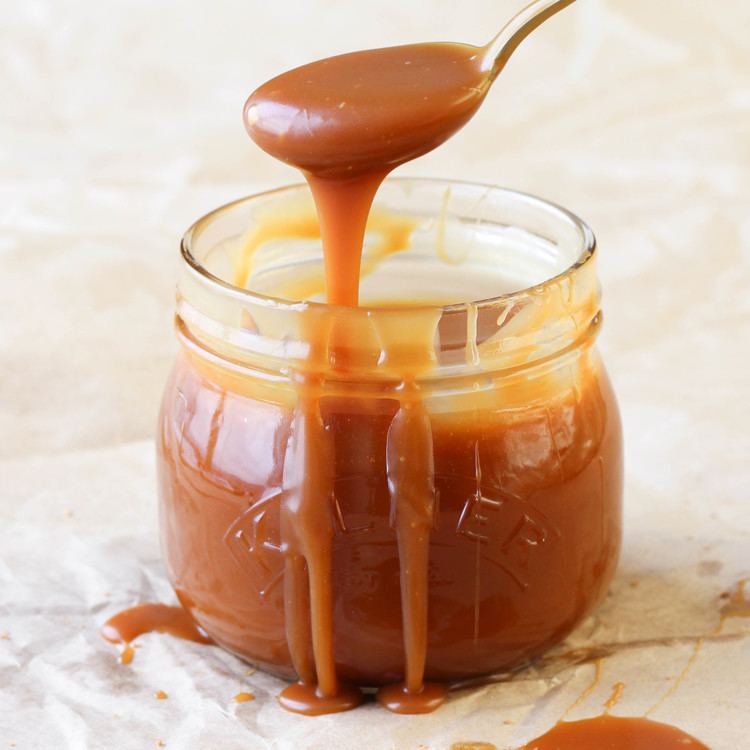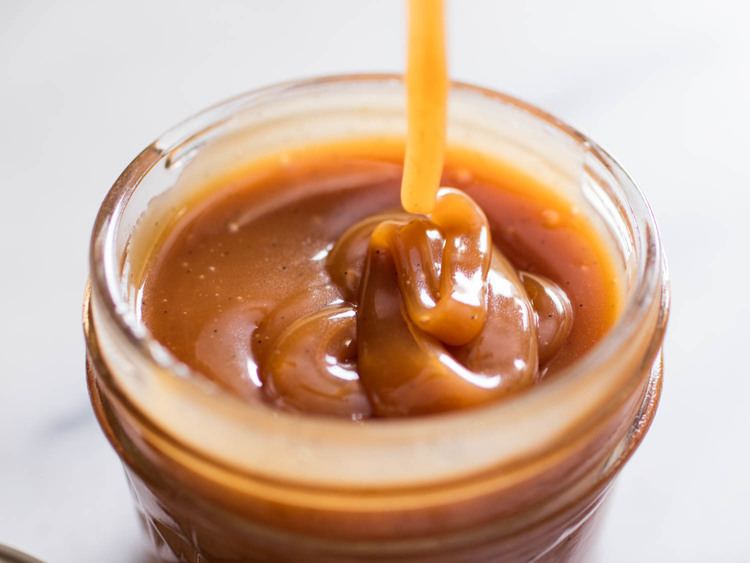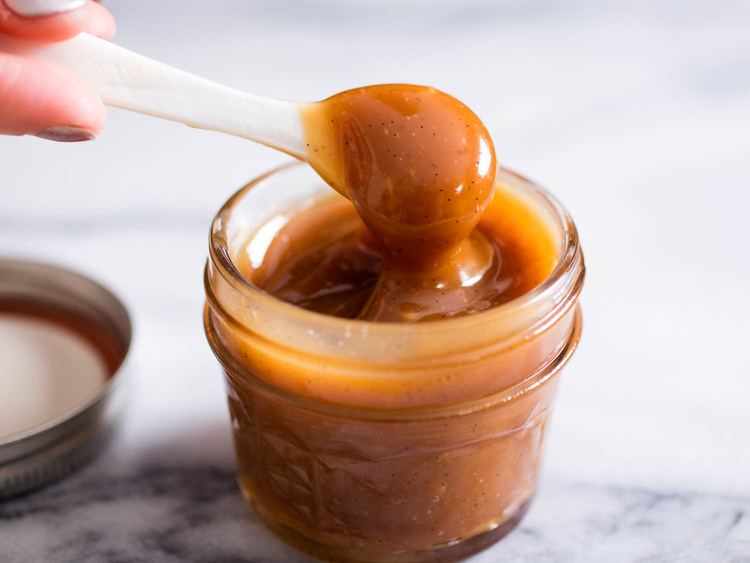 | ||
Similar Chocolate, Sugar, Dessert, Vanilla, Toffee | ||
Marceline s confectionery making tie dye mickey mouse caramel apples with sprinkles
Caramel (/ˈkærəmɛl/ or /ˈkɑːrməl/) is a beige to dark-brown confectionery product made by heating a variety of sugars. It can be used as a flavoring in puddings and desserts, as a filling in bonbons, or as a topping for ice cream and custard.
Contents
- Marceline s confectionery making tie dye mickey mouse caramel apples with sprinkles
- diy valentine s day gift caramel chocolate candy aprilathena7
- Etymology
- Caramel sauce
- Caramel candy
- Caramel coloring
- Chemistry
- Nutritional information
- References
The process of caramelization consists of heating sugar slowly to around 170 °C (340 °F). As the sugar heats, the molecules break down and re-form into compounds with a characteristic color and flavor.

A variety of candies, desserts, and confections are made with caramel: brittles, nougats, pralines, crème brûlée, crème caramel, and caramel apples. Ice creams sometimes are flavored with or contain swirls of caramel.

diy valentine s day gift caramel chocolate candy aprilathena7
Etymology
The English word comes from French caramel, borrowed from Spanish caramelo (18th century), itself possibly from Portuguese caramel. Most likely that comes from Late Latin calamellus 'sugar cane', a diminutive of calamus 'reed, cane', itself from Greek κάλαμος. Less likely, it comes from a Medieval Latin cannamella, from canna 'cane' + mella 'honey'. Finally, some dictionaries connect it to an Arabic kora-mochalla 'ball of sweet'.
Caramel sauce

Caramel sauce is made by mixing caramelized sugar with cream. Depending on the intended application, additional ingredients such as butter, fruit purees, liquors or vanilla are often used. Caramel sauce used in a variety of desserts, though most notably as a topping for ice cream. When it is used for crème caramel or flan, it is known as clear caramel and only contains caramelized sugar and water. Butterscotch sauce is made with dark brown sugar, butter and often a splash of whiskey. Traditionally, butterscotch is a hard candy more in line with a toffee, with the suffix "scotch" meaning "to score".
Caramel candy

Toffee, or in the US "caramel candy", is a soft, dense, chewy candy made by boiling a mixture of milk or cream, sugar(s), glucose, butter, and vanilla (or vanilla flavoring). The sugar and glucose are heated separately to reach 130 °C (270 °F), the cream and butter are then added which cools the mixture. The mixture is then stirred and reheated until it reaches 120 °C (250 °F). Upon completion of cooking, vanilla or any additional flavorings and salt are added. Adding the vanilla or flavorings earlier would result in their burning off at the high temperatures. Adding salt earlier in the process would result in inverting the sugars as they cooked.
Alternately, all ingredients may be cooked together. In this procedure, the mixture is not heated above the firm ball stage (120 °C [250 °F]), so that caramelization of the milk occurs. This temperature is not high enough to caramelize sugar and this type of candy is often called milk caramel or cream caramel.
Caramel coloring
Caramel coloring, a dark, bitter-tasting liquid, is the highly concentrated product of near total caramelization, bottled for commercial use. It is used as food coloring and in beverages, such as cola.
Chemistry
Caramelization is the removal of water from a sugar, proceeding to isomerization and polymerization of the sugars into various high-molecular-weight compounds. Compounds such as difructose anhydride may be created from the monosaccharides after water loss. Fragmentation reactions result in low-molecular-weight compounds that may be volatile and may contribute to flavor. Polymerization reactions lead to larger-molecular-weight compounds that contribute to the dark-brown color.
In modern recipes and in commercial production, glucose (from corn syrup or wheat) or invert sugar is added to prevent crystallization, making up 10%–50% of the sugars by mass. "Wet caramels" made by heating sucrose and water instead of sucrose alone produce their own invert sugar due to thermal reaction, but not necessarily enough to prevent crystallization in traditional recipes.
Nutritional information
Two tablespoons (i.e., 41 grams) of commercially prepared butterscotch or caramel topping contain:
